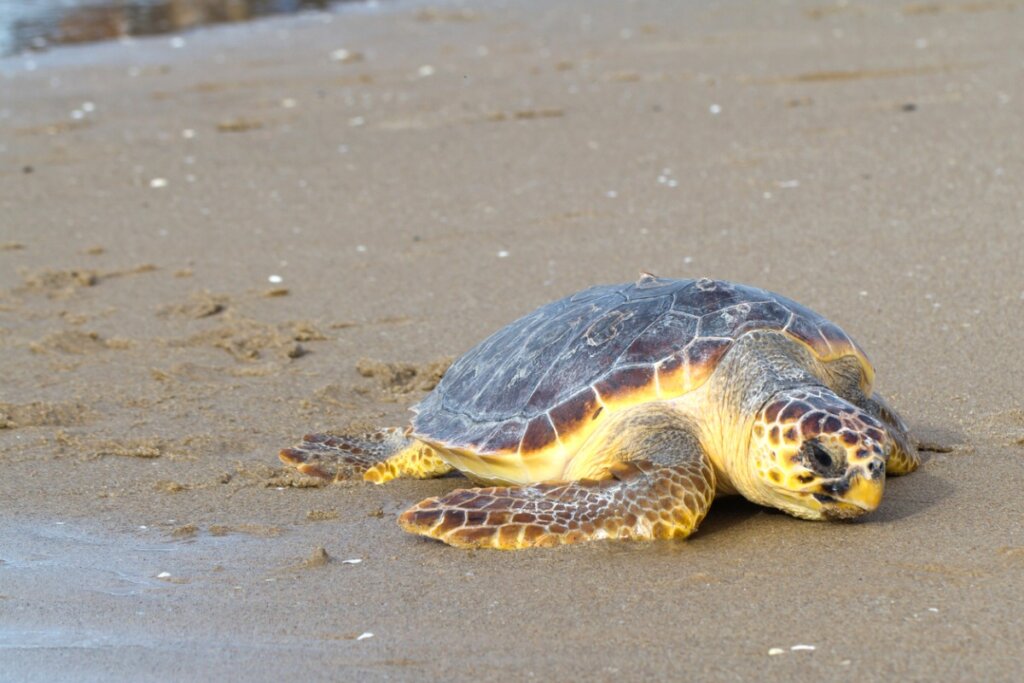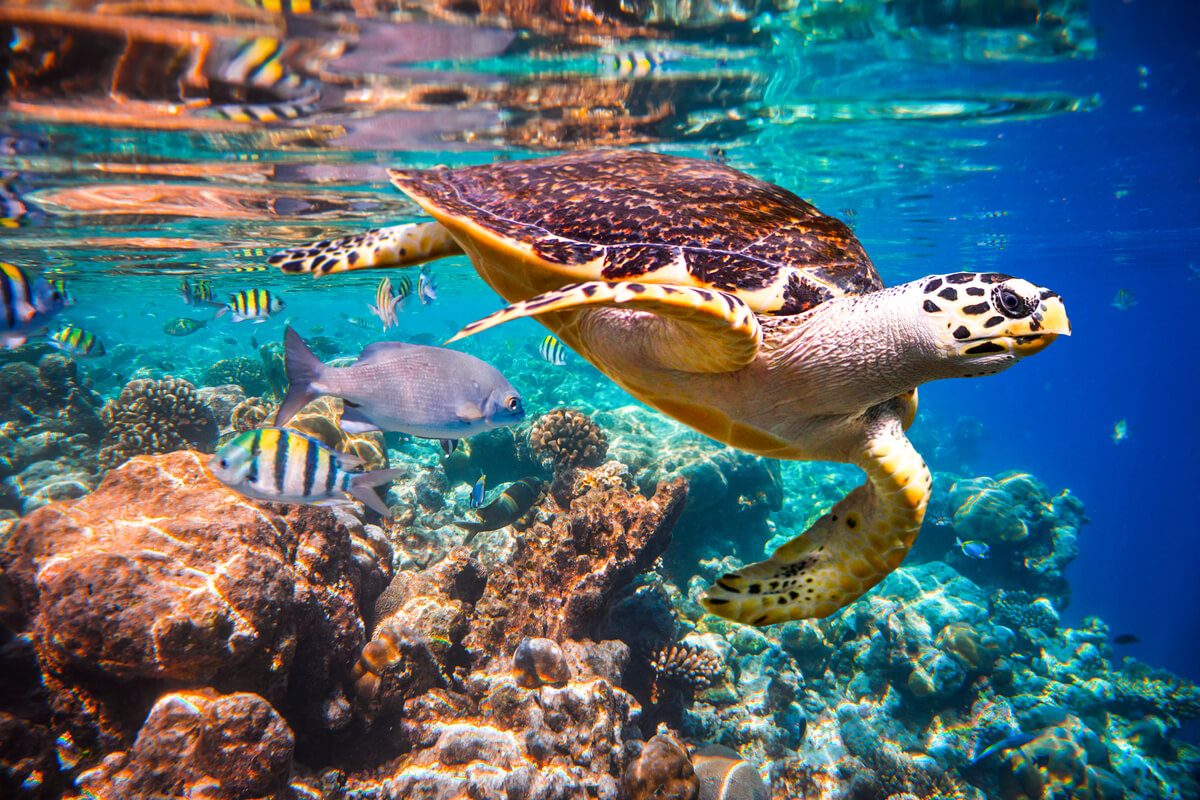Colomera: The Extraordinary Journey of a 100-Kilo Turtle

From the time they hatch until when they return to the same beach where they first saw the moonlight, some turtles will have traveled hundreds of kilometers. This is the case of Colomera, a turtle released in the Mediterranean after being caught in a trawl net. Thanks to the tracking device that has been implanted in it, it has been possible to record its route since its release.
If you want to know more about this animal and what makes it so special, read on to find all about it, as well as its conservation status.
Be sure to read about the tremendous journey that this turtle makes, as it’s a golden opportunity to learn more about the mysteries of marine wildlife.
Physical characteristics of the loggerhead turtle
The loggerhead turtle (Caretta caretta) is the only species of the genus Caretta, itself belonging to the family Cheloniidae. It inhabits the Atlantic (from where it moves to the Mediterranean Sea), Pacific and Indian Oceans.
This species is the largest hard-shelled turtle in the world: adults can weigh up to 200 kilograms and measure almost one meter (3.3 feet) in length. However, the record so far stands at 545 kilograms (1200 pounds) and 213 centimeters (7 feet).
The loggerhead turtle can’t retract its limbs into its shell, although the shell is hard and made up of large plates or shields. Behind each eye it has lacrimal glands that help it eliminate excess salt from drinking seawater, giving the sensation of crying when it does so out of the water.
The colours of this species vary from pale yellow to reddish brown, orange and greyish green.
It’s a species that shows sexual dimorphism in its adult stage. Male Caretta caretta have longer tails and claws than females, as well as a shorter plastron. Females, on the other hand, have a more convex carapace than males and a smaller head. In hatchlings, sex can only be determined through techniques such as laparoscopy or cellular anatomy.

Liberation of the turtle Colomera
Colomera, the turtle in our story today, was caught in a trawling net of fishermen from Burriana and Benicarló in Valencia, Spain. After her rescue, she spent some time at the ARCA del Mar del Oceanogràfic to recover. Once she was fit to be returned to her environment, she was fitted with a tracking device and was released in Oropesa del Mar (Valencia, Spain) on June 25, 2020.
This device has the capacity to transmit for 750 days if the technical, oceanographic or biological conditions of the animal don’t prevent it.
Colomera weighs 100 kilos (220 pounds) and measures about 87 centimeters (nearly 3 feet). This female is the largest of all those that have been recorded in the Oceanogràfic’s ARCA del Mar throughout its history. In addition, it was accidentally captured in 2015 and 2019 and, on both occasions, it passed through the turtle hospital.
The route of the Colomera turtle
After its release, Colomera passed the Columbretes Islands and continued its journey towards the Balearic Islands. There she traveled along the coasts of Palma de Mallorca and in mid-July she was in the Sicilian Channel, between the coasts of Tunisia and Sicily.
The speed and route of Colomera have greatly pleased the carers and researchers of the ARCA, as the data transmitted by her device indicate that her behavior is within the normal range.
It can be cautiously affirmed that her treatment and adaptation to the sea have been successful, critical steps in its liberation.
6 months off the coast of Greece
After her incursion into the Sicilian Channel, Colomera continued her route to Greece. She stayed there for 6 months, specifically in the Gulf of Ciparisia, located on the western coast of the Peloponnese peninsula (near the Ionian Sea).
She then began to head towards the Strait of Messina, at the tip of the boot of Italy and the island of Sicily. Colomera then returned to the Sicilian Channel, this time near the island of Malta. This last data is from 10 March 2021.
Conservation status
The Caretta Caretta, despite its distribution in most oceans, is currently in a vulnerable state. Human activities, together with the late sexual maturation of this turtle (at 19 years of age), make the recovery of populations a difficult task. The main threats facing the loggerhead turtle are as follows:
- Intensive hunting for its meat and eggs. Paradoxically, its consumption has been shown to be harmful to health due to the accumulation of bacteria and toxic metals.
- Unsustainable fishing in the fishing grounds where they feed: This, in addition to leaving the turtles without any food, increases the incidence of accidental capture of loggerhead turtles.
- The use of fishing techniques such as trawling and pelagic longlining: This is the main threat to turtles in the North Pacific, where they die from entanglement or serious injury.
- Ocean litter: About 24,000 metric tons of plastic are dumped into the ocean each year. Turtles (and other animals) ingest a wide range of this floating debris when they mistake it for food, such as plastic bags.
- Artificial lighting of nesting shores: Hatchlings, guiding themselves by moonlight to reach the sea, become confused at birth and make their way to cities due to the artificial lighting. On the way, they’re preyed upon, victims of traffic accidents, and become dehydrated, among other problems.
- Invasion and destruction of their habitat: The occupation and urbanization of loggerhead turtle nesting beaches force them to lay their eggs closer to the waves, or they’re unable to do so due to the sedimentation of the sand.
- Climate change: The sex of turtles is determined by the temperature of the nest. Higher temperatures due to global warming skews populations towards females, while nests dug in the shade of coastal buildings will result in more males.
The Colomera turtle is just one example of many that have done really well. However, the conservation of this species faces many enemies, much frustrations, and many tears. However, the people fighting for clean, safe oceans for their inhabitants are certainly not giving up!
All cited sources were thoroughly reviewed by our team to ensure their quality, reliability, currency, and validity. The bibliography of this article was considered reliable and of academic or scientific accuracy.
- Casale, P. & Tucker, A.D. 2017. Caretta caretta (amended version of 2015 assessment). The IUCN Red List of Threatened Species 2017: e.T3897A119333622. https://dx.doi.org/10.2305/IUCN.UK.2017-2.RLTS.T3897A119333622.en. Downloaded on 31 August 2021.
- La tortuga Colomera vuelve desde Grecia por la misma ruta – Oceanogràfic de València. (s. f.). Oceanogràfic de València. Recuperado 31 de agosto de 2021, de https://www.oceanografic.org/la-tortuga-colomera-grecia/